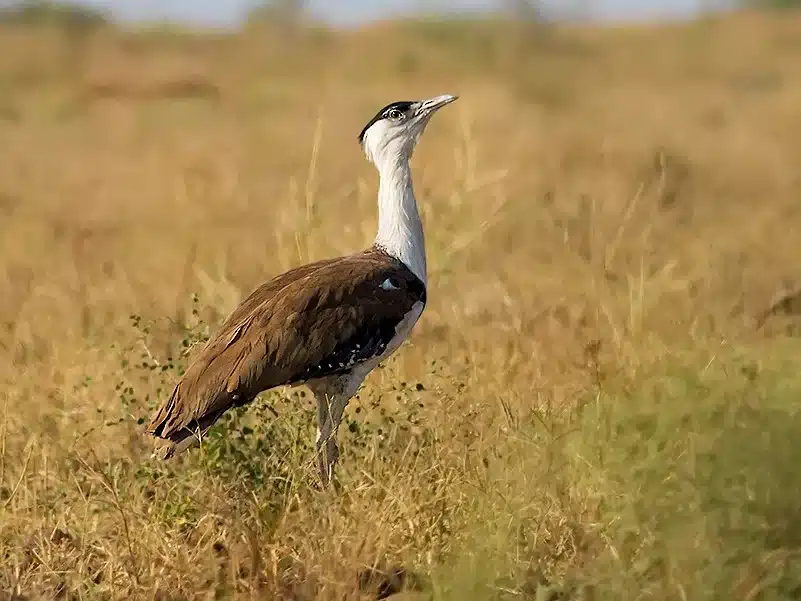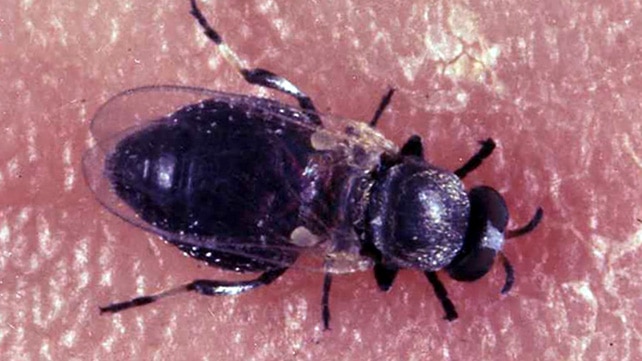Recently, the Supreme Court said it will review its April 2021 order to bury underground all power lines in the habitat of the Great Indian Bustard (GIB). This was after the Centre found the order practically impossible to implement over long distances.
About Great Indian Bustard
- It is a bustard found on the Indian subcontinent.
- Scientific Name: Ardeotis nigriceps
- It is among the heaviest of the flying birds.
- Distribution: The species has a current viable population of 100- 150 individuals in India and mainly survives in the Thar Desert of Rajasthan that holds about 100 individuals.
- Habitat: It inhabits dry grasslands and scrublands.
- Features:
- It is a large bird with a horizontal body and long, bare legs, giving it an ostrich-like appearance.
- The sexes are roughly the same size, with the largest individuals weighing 15 kg (33 pounds).
- It can easily be distinguished by its black crown on the forehead, contrasting with the pale neck and head.
- The body is brownish, and the wings are marked with black, brown, and grey.
- They breed mostly during the monsoon season, when females lay a single egg on open ground.
- Lifespan: 12-15 years
- These birds are opportunist eaters. Their diet ranges widely depending on the seasonal availability of food. They feed on grass seeds, insects like grasshoppers and beetles, and sometimes even small rodents and reptiles.
- Conservation Status:
- IUCN Red List: Critically Endangered
- Wildlife (Protection)Act, 1972: Schedule 1
- CITES: Appendix 1
Supreme Court’s Intervention
- 2021 order of SC
- The SC in April 2021 ordered that all overhead power transmission lines in core and potential GIB habitats in Rajasthan and Gujarat be made underground.
- The SC also formed a three-member committee, including Devesh Gadhvi, a member of the bustard specialist group of IUCN, to help power companies comply with the order.
- Review in 2022
- Again, in November 2022, the court sought reports from chief secretaries of the two states in six weeks on the installation of bird diverters in priority areas.
- It also asked them to assess the length of transmission lines needed to go underground.
- March 2024 order of SC
- In March 2024, the Supreme Court said it would review its April 2021 order to bury underground all power lines in the habitat of the GIB.
- It also created a seven-member committee that will suggest steps to protect and conserve the GIB, identifying critical areas where power lines may have to go underground.
Arguments of the Centre on the issue of undergrounding all power lines
- The Centre said taking lines of 66 KV and higher voltage underground was not feasible for the evacuation of bulk power.
- This is due to constraints such as transmission losses, maintenance challenges, multiple cable joints, increased time requirements, and concerns of safety.
Last updated on November, 2025
→ Check out the latest UPSC Syllabus 2026 here.
→ Join Vajiram & Ravi’s Interview Guidance Programme for expert help to crack your final UPSC stage.
→ UPSC Mains Result 2025 is now out.
→ UPSC Notification 2026 is scheduled to be released on January 14, 2026.
→ UPSC Calendar 2026 is released on 15th May, 2025.
→ The UPSC Vacancy 2025 were released 1129, out of which 979 were for UPSC CSE and remaining 150 are for UPSC IFoS.
→ UPSC Prelims 2026 will be conducted on 24th May, 2026 & UPSC Mains 2026 will be conducted on 21st August 2026.
→ The UPSC Selection Process is of 3 stages-Prelims, Mains and Interview.
→ UPSC Result 2024 is released with latest UPSC Marksheet 2024. Check Now!
→ UPSC Prelims Result 2025 is out now for the CSE held on 25 May 2025.
→ UPSC Toppers List 2024 is released now. Shakti Dubey is UPSC AIR 1 2024 Topper.
→ UPSC Prelims Question Paper 2025 and Unofficial Prelims Answer Key 2025 are available now.
→ UPSC Mains Question Paper 2025 is out for Essay, GS 1, 2, 3 & GS 4.
→ UPSC Mains Indian Language Question Paper 2025 is now out.
→ UPSC Mains Optional Question Paper 2025 is now out.
→ Also check Best IAS Coaching in Delhi

















